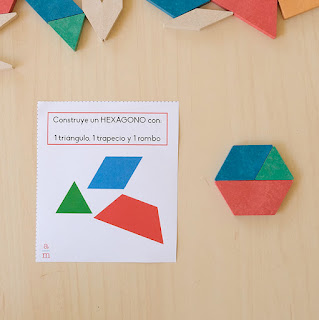- Obtener enlace
- Correo electrónico
- Otras aplicaciones
Entradas
Manipulative materials
- Obtener enlace
- Correo electrónico
- Otras aplicaciones

Geometry, like other areas of mathematics, is most effectively and enjoyably learned by observing, touching and experimenting. Therefore, the best way for children to discover this exciting field is through manipulative geometry. There is a wealth of manipulative materials with which children can explore, deduce and learn the geometric properties of figures and bodies as well as internalise increasingly complicated geometric concepts. I believe that including them in the classroom can provide us with an impressive richness and encourage children's interest and meaningful learning. Here is an example of a geometry manipulative material that has caught my attention: Geometric blocks This material consists of a set of flat figures with six different shapes: equilateral triangles, squares, hexagons, rhombuses (blue and grey) and trapezoids, each one in a different colour. They are versatile and we can create an infinite number
Geoplano
- Obtener enlace
- Correo electrónico
- Otras aplicaciones
Hello everybody! I have found a tool called "geoplano" and I think it is very interesting and useful, that's why I have decided to create this post so you can get to know it too. With this tool we can work on geometry in a manipulative and experimental way so that children understand what they are studying and doing while having fun. Some examples of topics that can be worked with this game are: Concave and convex polygons, triangles, height, perimeter, area, circles, sides, vertices, quadrilaterals etc... I attach the video below!
Audiovisual resources
- Obtener enlace
- Correo electrónico
- Otras aplicaciones
I think that visual aids are a very good tool to capture the attention of students and in this case I have found a video that in my opinion can be very useful as an introduction or review, this is very appropriate for dealing with geometric bodies, faces, edges, polyhedra, curved figures.... Here it is, I think it is very interesting and useful! This could be a good option to differentiate and understand the area and perimeter of figures:
Mandalas
- Obtener enlace
- Correo electrónico
- Otras aplicaciones

Mandalas are symbols used in Buddhism and Hinduism that are made up of a set of different shapes and concentric geometric figures. There are many benefits when applied to children, such as: improving concentration and encouraging creativity and patience, reducing stress, etc. We can also use them to work on different transversal contents including geometry, art, religion, etc. I think it can be a fun tool with which to work in different ways and encourage the interest and attention of students.